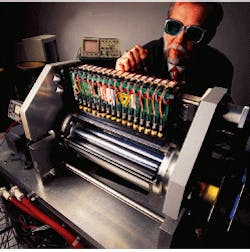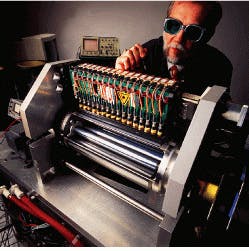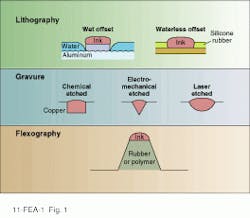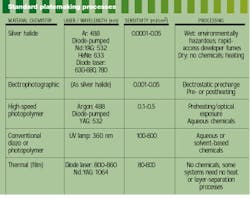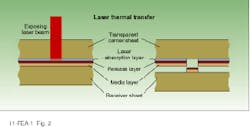Printing benefits from new technologies
LASERS FOR GRAPHICS
Printing benefits from new technologies
Ron Gibbs
Emerging prepress printing film and plate materials create new opportunities and challenges for lasers in prepress applications.
Since the early 1970s, lasers have played a vital role in the development of electronic prepress systems. Both typesetters and color separators evolved as digital systems because of the development of high-speed, high-quality laser output recorders, together with high-resolution, high-contrast film materials. These systems produced text--using 633-nm HeNe lasers--and halftone graphics images--using 488-nm air-cooled argon-ion lasers--on film or paper. After exposure, the films were manually assembled to form complete pages, and several pages were then combined, together with various print-control marks, to produce an imposed printing form.
For color printing, one form is needed for each of the process colors, which are usually black, cyan, magenta, and yellow. The form acts as an exposure mask for production--with UV floodlamps--of halftone color proofs and the final printing surface. Lithographic plates are produced using diazo or photopolymer chemistry, while gravure and flexographic cylinder production use photoresists and chemical etching (see Fig. 1). Prepress proofs are made with electrostatic toner chemistry that simulates the printing inks.
For many years these were the standard processes for platemaking; film generation, proofing, and platemaking were all developed to optimize these processes (see table on p. 78). A few prepress-system vendors dominated the market, each with proprietary hardware and software standards. For the laser industry, the market for air-cooled argon-ion lasers was sufficiently large and stable to drive significant advances in reliability and quality, and graphics arts films were optimized for 488 and 633 nm.
The past few years, however, have seen a computer revolution in prepress. As the power of desktop computers and desktop publishing software has grown to match that of the proprietary typesetting and page-makeup systems--but at a fraction of the cost--an industry standard for integration of text and graphics has emerged in the form of Adobe Systems` PostScript Level 2 page-description language. Furthermore, page assembly and even plate imposition can now be carried out on both Apple Macintosh and PC desktop computers.
Dedicated typesetters and film recorders for color separation output, meanwhile, have been replaced by imagesetters that output combined text and graphics. In fact, very-large-format imagesetters have been developed that allow output of complete imposed page collections.
This change from proprietary to open systems has created new possibilities for dramatically changing the platemaking and printing processes. On the materials front, there has been an explosion of activity in laser-exposable media, much of it aimed at practical realization of computer-to-plate and direct-to-print printing systems. Thus, at DRUPA 95 (May 1995; Dusseldorf, Germany) new materials technology was very much in evidence. The printing industry`s largest trade exhibition, DRUPA is held every five years and attracts more than 1500 exhibiting companies and 400,000 visitors. Many new consumable products were launched, demonstrated, or announced at DRUPA and add to the already confusing variety of products.
High-sensitivity materials
Despite environmental concerns, silver halide chemistry remains significant because of its high sensitivity at visible wavelengths and its technological maturity. Recent developments in image-setting film have been aimed at extending the spectral sensitivity of silver halide media to enable the use of diode lasers at 780 nm and in the 630-680-nm region; also, for sharper output the film gamma is being increased. [A high gamma means that as the exposure from the laser increases, the film suddenly goes from clear to opaque for a very small increase in exposure at the "threshold" exposure level. The film is, therefore, either clear or opaque, with almost no grays in between--Ed.]. Several vendors at DRUPA 95 announced 780-nm sensitive, no-process film based on heat-developed dry silver technology originally developed by 3M (St. Paul, MN) for medical imaging.
As an alternative to silver halide, Xerox (Purchase, NY) has launched an electrophotographic film that needs no chemical processing. Verde film can be exposed on existing imagesetters with minor modifications. The polyester base of the film contains an embedded surface layer of selenium that, when electrically charged and exposed by a laser, diffuses into the base when subsequently heated to 100°C, thereby creating an image. Versions of this film have been developed for exposure at 488 nm or 633-780 nm.
Computer-to-plate exposure is now possible in platesetters with low-power lasers because of new lithographic-plate chemistries. In silver-diffusion systems, silver halide chemistry forms the printing surface directly by depositing areas of silver on an aluminum substrate. Hybrid silver systems contain a silver halide emulsion that is exposed and developed to form an exposure mask layer directly on top of a conventional diazo plate. This plate is then exposed to UV light and developed as part of the processing. Polyester-based silver halide plates can be imaged in unmodified red or IR imagesetters and are beginning to show high-quality color capability in short runs.
Electrophotographic lithography plates have been developed from organophotoconductor (OPC) materials, and evolution of Xerox`s Verde film technology into plates is likely. Electrophotographic color-copier/printer technology is also finding a place in commercial print through major office-equipment vendors such as Fuji/Xerox, Canon, and Eastman Kodak (Rochester, NY); resolution is limited, however, by dry-toner particle size. A digital press has been developed by Xeikon (Mortsel, Belgium) in partnership with Agfa (Mortsel, Belgium). The device uses a red-light-emitting diode-array for exposure, with ultrafine dry toner materials supplied by Agfa.
Very-high-resolution (1800 dots per inch [dpi]) electrophotographic halftone color proofing systems, using fine toners in a liquid suspension, emerged from Kodak and 3M about five years ago, while Indigo (Rehovot, Israel) developed a high-resolution (800 dpi), high-speed digital offset press, the E-Print 1000, that uses IR-sensitive OPC and liquid-toner technology, exposed by a monolithic diode-laser array.
Medium-sensitivity materials
Lower-sensitivity photomaterials, such as photopolymers and photoresists, require higher laser powers, generally in the blue or UV wavelength regions. Early attempts at computer-to-plate techniques by EOCOM (now Gerber, Hartford, CT) in the mid-1970s failed commercially, largely because of the poor reliability of the lasers necessary to expose conventional plate materials. Several watts of UV light are required, and the low efficiency of argon-ion lasers means that, even with today`s technology, the cost, size, and reliability of such lasers are unattractive for many.
In 1990, Hoechst (Wiesbaden, Germany) launched the Ozasol N90 photopolymer lithographic plate, which was not only much more sensitive, but was sensitive to blue-green wavelengths. This has achieved significant success, and many other suppliers now have similar plate products. The lasers used to expose these plates are either 488-nm air-cooled argon-ion lasers of 50 mW or more or 532-nm frequency-doubled diode-pumped solid-state Nd:YAG or Nd:YLF lasers.
Think Laboratories (Chiba, Japan) has also developed a laser exposure system for gravure cylinder production that images a photoresist layer with a 488-nm argon-ion laser, followed by chemical etching and chromium plating of the copper cylinder surface.
Low-sensitivity (thermal) materials
Some of the most exciting recent developments involve the use of a laser as a precisely controllable source of heat to raise the temperature of a surface or thin layer to a critical temperature. These methods are attractive because no chemical processing is needed, which eliminates potential environmental pollution and reduces the time, complexity, and cost of processing.
Surface engraving of rubber or polymer flexography cylinders by material vaporization with CO2 or Nd:YAG lasers has been around for several years. Two promising new systems for engraving gravure cylinders were shown at DRUPA 95. MDC Max Datwyler (Bleienbach, Germany) launched a direct engraving system based on a new infrared-absorbing metal alloy that is exposed by a Nd:YAG laser Q-switched at 35 kHz. The cylinder is chromium plated after engraving to give good abrasion resistance on the press.
Also, MAN Roland (Augsburg, Germany) showed a prototype of a digital gravure press. The system is based on a steel or ceramic cylinder with a pre-etched, polymer-filled, deep-cell structure that is engraved with a Nd:YAG laser to create the halftone image. In the 1980s, an innovative Lasergravure system from Crosfield (Hemel Hempstead, England) failed to progress beyond beta testing because its CO2 laser-etched polymer surface showed inadequate durability on the press, a problem addressed in different ways by these two new systems.
Several manufacturers, including Polaroid (Cambridge, MA), Kodak, and 3M, have developed film, plate, or halftone color-proofing materials in which a thin layer is removed or transferred by laser heating to form an image (see Fig. 2). The imaging systems are based on either Nd:YAG or high-power, infrared diode lasers; several individually modulated diode lasers are used or a diode bar illuminates a linear light valve array.
Pioneering work was carried out in the 1970s by LogeScan (acquired by Crosfield) with its Lasermask material, which consisted of a carbon layer on a nitrocellulose base. The carbon acted as an absorber of 1.06-µm light from a Nd:YAG laser and was ablated onto a sheet of aluminum, which then functioned as a short-run lithographic plate. The film could also be used for film-based processes, although both the mechanical stability of the film base and the durability of the carbon coating limited its usefulness.
In 1993, Presstek (Hudson, NH) developed a waterless lithographic plate technology; a laser-absorbing layer causes ablation of a silicone (ink repelling) layer. In what was probably the star product of DRUPA 95, Heidelberg (Heidelberg, Germany) integrated this plate technology with a four-color printing press. Each of the four plates is exposed with a Presstek-supplied array of 16 discrete fiber-coupled diode lasers, enabling on-press digital plate changing (see photo on p. 77).
Also at DRUPA 95, MAN Roland showed a prototype of an offset lithographic press in which erasable plates are produced on the press by laser thermal transfer of a polymer film material onto the printing cylinder; the film is exposed by a 64-element diode-laser array from CREO Products (Burnaby, BC, Canada).
This year also saw the launch of laser-exposed photopolymer flexography plates from DuPont Printing and Publishing (Wilmington, DE) and BASF (Stuttgart, Germany). These have an opaque outer layer that is ablated by a Nd:YAG laser to form an exposure mask for UV floodlamp exposure.
Opportunities
The printing industry is entering a period of radical change in which new laser technology will play a vital part. Gas lasers are being displaced by solid-state devices, and new requirements for high-power lasers are emerging. Film-based printing processes are likely to be replaced by computer-to-plate and direct-to-print techniques. These depend for their success on new materials that must be matched to lasers that meet the demanding requirements of new systems. Many of the recently announced new materials and exposure systems will fall by the wayside, although predicting the survivors is difficult. For the longer term, thermal processes have the greatest potential, but require the most development.
One answer to the ever-increasing imaging speed requirements is to use discrete or monolithic arrays of diode lasers, and it seems likely that vertical-cavity surface-emitting lasers will find a place in future low-to-medium sensitivity systems. The biggest challenges for the laser industry, however, are in high-power lasers for the wide variety of emerging thermal materials.
Multiple-beam modulators or light valves may allow use of more-powerful multimode lasers and diode-laser bars as an alternative to large numbers of high-power diode lasers. These solutions, however, limit the choice of scanning geometry and resolution range, which will rule them out for certain applications. Single-mode output power higher than is currently possible (30 W for lamp-pumped Nd:YAG and 10 W for diode-pumped lasers) will be necessary for future scanning speed requirements. And the challenge for laser gravure and flexography cylinder etching is to increase the modulation bandwidth of very-high-power lasers significantly above 30 kHz.
The printing industry remains full of opportunities and challenges for laser manufacturers, with reliability, cost, and, in some applications, size, also being critical success factors in a competitive OEM market. n
Array of 16 discrete fiber-coupled diode lasers integrated into four-color printing press enables on-press digital plate changing.
FIGURE 1. Primary print processes are based on different chemistries and rely on different techniques to transfer an image (printing ink) to paper. Lithography (top) typically relies on diazo or photopolymer chemistry, while gravure (middle) and flexographic cylinder production (bottom) use photoresists and chemical etching to create an image.
FIGURE 2. Thermal transfer processes typically involve removal or transfer of a thin layer of material by laser heating. In most products either the carrier sheet (usually polyester) or the receiver sheet (aluminum or paper) may be absent, and the media layer can be printing ink, dye, or film. Laser-absorption, release, and media layers can be combined in one or two physical layers.
